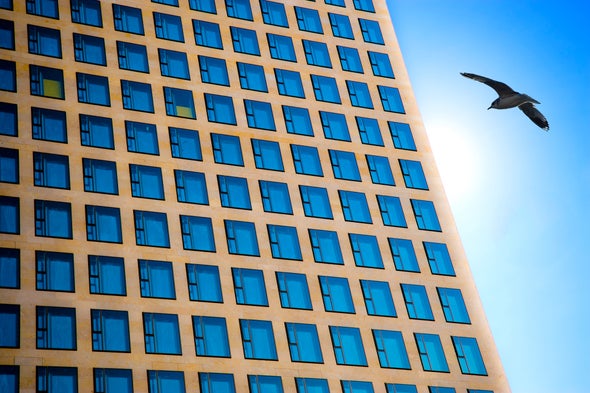(单词翻译:单击)
听力文本
This is Scientific American's 60-second Science, I'm Jason Goldman.
About a billion birds die from flying into buildings each year in North America. Suspicions have been that birds may perceive the open areas behind glass as safe passageways. Or they may mistake the reflected foliage for the real thing.
Researchers would like to reduce collisions, which requires a solid understanding about what makes a bird more or less likely to die by smacking into a building in the first place.
"There was, and still is, relatively little known at a broad scale. Most studies are at one small study site."
Jared Elmore, a graduate student in natural resource ecology and management at Oklahoma State University. He and his colleagues used a previously created data set of building collisions for birds at 40 sites throughout Mexico, Canada and the U.S.

The first finding was obvious: bigger buildings with more glass kill more birds. But the details were more noteworthy.
"We found that life history predicted collisions. Migrants, insectivores and woodland-inhabiting species collided more than their counterparts."
Most migratory species travel at night, when lights near buildings can distract or disorient them. And Elmore thinks that insect-eating birds might be attracted to buildings because their insect prey is attracted to the lights. He suspects that woodland species get fooled by the reflections of trees and shrubs in the windows. The results are in the journal Conservation Biology.
By understanding which birds are more likely to collide with buildings, researchers can perhaps determine the best way to modify buildings, or their lighting, to help prevent such accidents. And by knowing risks, along with migration timing and behavior, building managers can better anticipate when birds are at their greatest danger—and modify lighting strategies accordingly.
Elmore's next project will use radar to help predict bird migrations.
"I think that would maybe go a long way in terms of providing information to people, to the public, to building managers, on when they can get the most bang for their buck in terms of lights-out policies."
Thanks for listening for Scientific American's 60-second Science. I'm Jason Goldman.
参考译文
这里是科学美国人——60秒科学系列,我是杰森·古德曼。
北美每年约有10亿只鸟因撞上建筑物而死亡。人们一直怀疑鸟类可能是将玻璃后面的开放区域当成了安全通道。或者它们可能是误将被反射的植物当成了真植物。
研究人员希望减少撞击,这首先需要对鸟儿为何或多或少地容易撞上建筑物而死亡有充分的理解。
“我们的广泛理解,过去乃至现在都相对较少。大多数研究都在一个小的研究地点进行。”
俄克拉荷马州立大学的自然资源生态与管理学研究生贾里德·埃尔莫尔说到。他同事使用了之前创立的鸟类撞击建筑物的数据库,这些建筑物分布在墨西哥、加拿大和美国的40个地点。
第一个发现是显而易见的:建筑物越大、玻璃越多,杀死的鸟儿就越多。但细节更值得注意。
“我们发现生活史预测了撞击情况。悠久、食虫动物和栖居于林地的鸟类,撞击次数要多于同类。”
大多数候鸟在夜间飞行,那时建筑物附近的灯光会分散它们的注意力或使它们迷失方向。埃尔莫尔认为,食虫鸟被吸引到建筑物,可能是因为昆虫猎物被灯光所吸引。他怀疑林地鸟类被窗户上的树木和灌木的倒影所欺骗。这项研究发表在《保护生物学》期刊上。
通过了解哪些鸟类更容易撞上建筑物,研究人员或许可以确定改造建筑物或灯光的最佳方法,以帮助防止此类事故的发生。通过了解迁徙时机和行为以及风险,建筑管理者可以更好地预测鸟类何时处于最大危险,并相应地修改照明策略。
埃尔莫尔的下一个项目将使用雷达来帮助预测鸟类迁徙。
“我认为,这在向人们、公众、建筑管理者提供信息方面可能大有帮助,可以告诉他们如何设置熄灯政策才能获得最大回报方面。”
谢谢大家收听科学美国人——60秒科学。我是杰森·古德曼。
译文为可可英语翻译,未经授权请勿转载!
重点讲解
重点讲解:
1. perceive as 看作;视为;认为;
They strangely perceive television as entertainment.
奇怪的是,他们居然将电视看作娱乐。
2. in the first place 起初;一开始;首先;
Well, in the first place he has all the right qualifications.
噢,首先,他符合一切条件。
3. at night 在晚间;在夜里;
These animals only come out at night.
这些动物只在夜晚出来。
4. along with 与…一起;
She lost her job when the factory closed, along with hundreds of others.
工厂倒闭时,她和成百上千的其他人一样失去了工作。


